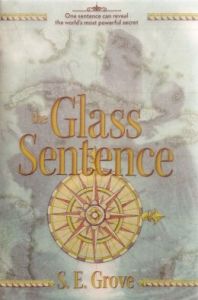The Glass Sentence (The Mapmakers Trilogy #1) by S. E. Grove. Viking, 2014, 489 pages.

Reading Level: Middle grades, ages 12-14
Maturity Level: 6 (ages 15-18) and up
Boston, 1799: . . . in one terrible moment the various parts of the world had come apart. They were unfastened in time. Spinning freely in different directions, each piece of the world had been flung into a different age. When the moment passed the pieces lay scattered, as close to each other in space as they had always been but hopelessly separated by time.
The reader has to accomplish a similar trick to comprehend the basic premise of this story: fling out the pieces of logic in suspension of disbelief. The description above is how Elizabeth Elli recalled the Great Disruption for her grandson Shadrach. Now Shadrach Elli is grown, a renowned cartologer of New Occident (what we know as the northeastern USA) and guardian of his 13-year-old niece Sophie, whose explorer parents failed to return from their latest mission. The year is 1891, or at least it is in New Occident. Other regions have their own ways of measuring time, and their own reality. Partly for that reason, New Occident is drumming up an anti-immigration movement that Shadrach opposes. Both he and Sophie feel a strong pull toward the “Other” and its unexplored lands, religions, and ways of thinking. That’s the appeal of the feather-clad young man in a cage that Sophie meets down at the docks: part of a circus sideshow from the neighboring space-time continuum. Then her house is broken into, Shadrach is kidnapped, and the young man shows up looking for a map.
So the quest is joined. The plot is mind-bending, with colorful characters and intriguing mysteries, but for me it didn’t quite gel. How much of this world can we believe? “Memory is a tricky thing . . . It doesn’t just recall the past; it makes the past.” Okay, but can time be separated from space, even in imagination? “You see things for what they are regardless of when they are,” Sophia is told, and that’s supposed to be an advantage. I’m not so sure: can what be completely free of when? Certainly from God’s point of view, but how about ours? At least I’m thinking. Two more volumes will answer our questions—or maybe not.
Overall value: 3.5
- Worldview/moral value: 3
- Artistic value: 4
Cautions: Violence (somewhat disturbing in places), Character issues (sympathetic characters lie)
Recommended use: discussion starter, independent reading
Discussion Points
Literary element: Which characters do you sympathize with the most? Why?
Thematic element: Do you think it’s possible for a material being to separate from time? Why or why not? What part does memory play in our personhood?
Worldview element: The author invents a “new” philosophy/theology. What is “Nihilismianism” and how does it compare with Christianity?
Categories: FICTION, SPECULATIVE FICTION, alternate history, PHYSICS, maps
Stay Up to Date!
Get the information you need to make wise choices about books for your children and teens.
Our weekly newsletter includes our latest reviews, related links from around the web, a featured book list, book trivia, and more. We never sell your information. You may unsubscribe at any time.
Support our writers and help keep Redeemed Reader ad-free by joining the Redeemed Reader Fellowship.
Stay Up to Date!
Get the information you need to make wise choices about books for your children and teens.
Our weekly newsletter includes our latest reviews, related links from around the web, a featured book list, book trivia, and more. We never sell your information. You may unsubscribe at any time.
FREE Bible Guide!
Get a guide to the Best Bibles for Children and Teens. Perfect for an Easter gift.
We'd love to hear from you!
Our comments are now limited to our members (both Silver and Golden Key). Members, you just need to log in with your normal log-in credentials!
Not a member yet? You can join the Silver Key ($2.99/month) for a free 2-week trial. Cancel at any time. Find out more about membership here.
4 Comments
Leave a Comment
You must be logged in to post a comment.


The maturity level ratings and discussion questions are so valuable. Thank you for taking time to add them to your reviews!
Glad you like them, Kristina! We are working hard to make the site easier and more helpful. : ) Let us know if you think of anything else we might change!
I need some help, I’ve read the book and am trying to clarify so I can read this to my gr. 5 class next year. When the great disruption occurred, I understand that places fell into different eras but did the people on these places transformed to people of that time or are they all from the time of the disruption but now seeing things, not people, from different ages?
Sandy,
Whew! that was a long time ago! (that I read the book) To the best of my memory, though, the people in the neighboring provinces are living forward from their time at the disruption. So time is moving forward everywhere, but from different starting points at possibly at different rates. I didn’t understand how would affect people from one province traveling in another, but I couldn’t quite get a grip on the concept as a whole.